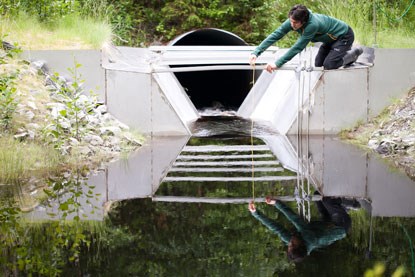18O and 2H
Water samples are analysed for δ18O and δ2H on a Picarro cavity ringdown laser spectrometer (L2130-i) with a vaporizer module (A0211), (Picarro, Inc 3105 Patrick Henry Drive, Santa Clara, 95054, USA). Each sample is injected four times and the data is averaged after drift and memory correction to give the final results. Corrections are done according to the method by van Geldern and Barth (2012). Isotopic signatures of the samples are calibrated using three inhouse laboratory standards, which have been standardised against three International Atomic Energy Agency (IAEA) official standards: The Vienna Standard Mean Ocean Water (VSMOW); the Greenland Ice Sheet Precipiation (GISP); and the Standard Light Antarctic Precipitation (SLAP) (Announcement, 1995).
The accepted standard deviation of the control samples is 0.15‰ for δ18O and 0.3‰ for δ2H. The precision for water samples at natural abundance is typically less than 0.15 ‰ for δ18O and less than 1.5 ‰for δ2H. A sample with known isotopic composition is included in every batch as a quality control.
During autumn 2017 we will install a new EA/TC-IRMS to be able to analyse water samples containing higher concentrations of organic matter.
13C-DIC
Water samples are analysed on a GasBench - Isotope Ratio Mass Spectrometer (GB-IRMS). The instrument setup consists of a gas bench (GasBench II) connected to a continuous flow isotope ratio mass spectrometer (DeltaV), both from Thermo Fisher Scientific, Bremen, Germany. Each sample is injected seven times in the instrument. Data from the first two injections are discarded and data from the other five injections is averaged and corrected for blank, drift and size before given the final results. Isotopic signatures of the samples are calibrated using two inhouse laboratory standards, which have been standardised against four certified standards: IAEA-600, USGS 40, IAEA-CH-6, NBS 19. A sample with known isotopic composition is included in every batch as a quality control.
The accepted standard deviation of inhouse laboratory standards is <0.15‰ for δ13C.
18O of dissolved O2
18O-O2 in gas samples is analyzed using a Gas Bench - Isotope Ratio Mass Spectrometer (GB-IRMS). The instrument setup consists of a gas bench (GasBench II) connected to a continuous flow isotope ratio mass spectrometer (DeltaV), both from Thermo Fisher Scientific, Bremen, Germany. The sample is purged from the vial into a helium carrier stream and transferred to the IRMS. The resulting data is corrected for drift and size using oxygen in outdoor air. In each sequence, at least one sample of synthetic air is included and used for quality control.
The accepted standard deviation of oxygen in outdoor air is <0.15‰ for δ 18O.
